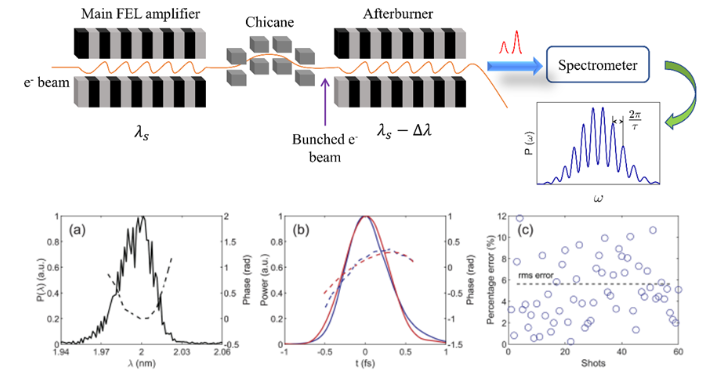Research Progress
Novel Approach for Single-Shot Characterization of Ultrashort Free-Electron Laser Pulses
date:
2023-11-24
Attosecond light pulses can be used to observe and manipulate the electronic motion within atoms and molecules, thus helping scientists to gain a deeper understanding of chemical reactions, electronic structures, and molecular dynamics. The complete spectrotemporal characterization of attosecond X-ray free-electron lasers is of great significance to ultrafast scientific experiments. However, the high-precision single-shot characterization of these pulses has been a key bottleneck in the application of attosecond X-ray free-electron lasers.
To address this issue, the free electron laser team led by Prof. FENG Chao at the Shanghai Advanced Research Institute (SARI) of the Chinese Academy of Sciences (CAS) proposed and validated a novel approach for single-shot characterization of ultrashort free electron laser pulses based on self-referenced spectral interferometry.
The research results were published in Physical Review Letters.
The team innovatively proposed a method of using the frequency-pulling effect as a way to induce the spectral shear. Through this method, both the ultrafast radiation pulse and the reference pulse will be generated from the same electron beam, enabling self-referenced spectral interferometry of the radiation pulse.
With the help of the parameters of the Shanghai soft X-ray free-electron laser facility, researchers demonstrated that this method can accurately reconstruct the complete spectrotemporal information of attosecond X-ray pulses, and the reconstruction error rate was less than 6 percent.
Compared to traditional ultrafast pulse characterization methods in free-electron laser facilities, this method has several advantages. It involves only simple equipment, but can yield high diagnostic efficiency (real-time, single-shot), with simultaneous acquisition of complete spectrotemporal information, and higher diagnostic precision for shorter radiation pulses. These advantages provide a novel diagnostic approach for the optimization and fine-tuning of ultrafast X-ray free-electron lasers and future attosecond scientific experiments based on X-ray free-electron lasers.
This study can provide a fresh approach to address the challenge of high-precision real-time diagnostics for attosecond free electron laser pulses.

Schematic layout of the proposed method and spectrotemporal reconstructions of attosecond X-ray free-electron laser pulses (Image by SARI)





